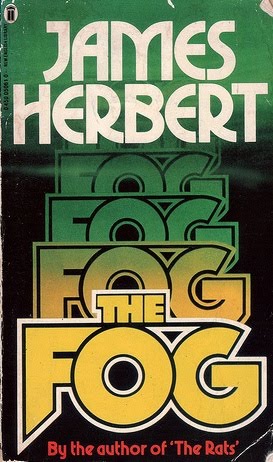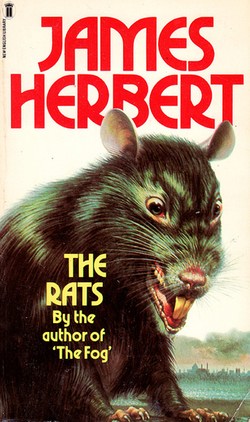Summer of Sleaze is 2014’s turbo-charged trash safari where Will Errickson of Too Much Horror Fiction and Grady Hendrix of The Great Stephen King Reread plunge into the bowels of vintage paperback horror fiction, unearthing treasures and trauma in equal measure.
Books win awards. Books drink white wine. Books are discussed in hushed tones by earnest scholars. Books are genteel, books are mellow, books are housed in libraries where there is no talking. It’s hard to remember that books can be a punch in the nose, a bottle of beer broken over the head, a gob spat in the eye. Amiri Baraka’s in-your-face plays, Tom Wolfe’s go-go new journalism, Kathy Acker’s punk poetry. These writers set literature on fire and readers could either get on board or fuck off. James Herbert was one of them.
By the time he died last year he was a mainstream success, but his two earliest books are nasty, mean, angry pieces of anti-establishment sleaze torn straight out of his id, redeemed by Herbert’s complete conviction to Go There. That conviction is what keeps these two books in your hands long after you might otherwise throw them across the room. Read Herbert and you’re like a baby gripping a 10,000 volt cable, hands smoking, unable to tear them away even as your brain turns to cinders.
James Herbert is the UK’s most successful horror novelist, with 54 million books sold world wide, and while he went on to write ghost stories, and alternative histories, and thrillers, his first two books are proto-punk ragers: The Rats (1974) and The Fog (1975). Stephen King says they have a “raw urgency” and if by “raw” you mean, “totally flayed of skin” and if by “urgency” you mean, “gripping you by the collar and screaming in your face” then yes. In his non-fiction history of horror, Danse Macabre, King writes “If The Rats, with its scenes of gruesome horror and its blasted East End landscape, is not a literary version of ‘Anarchy in the UK,’ what is?” But the Sex Pistols are too consciously commercial for that comparison to ring true. Herbert is pub rock, the pre-punk, primal pushback against glam rock that was all hairy knuckles, screamed lyrics, two-chord thrashers, and no-future thinking. Pub rock’s raw fury burnt out fast, but so did Herbert’s. In fact, it only lasted for two books.
First up was The Rats, which is a blockhead of a book. What is The Rats about? Rats. What do they do? Eat everyone. Martin Amis, reviewing for The Observer, wrote that it was, “Enough to make a rodent retch, undeniably, and enough to make any human pitch the book aside.” But even back then no one cared what Amis had to say, and the initial 100,000 print run sold out in a couple of weeks. Why was it a success? Because rats. They eat everything.
By chapter three they’ve eaten a puppy and ripped the flesh off a baby. There’s stream of consciousness narration as people are eaten alive. “Rats! His mind screamed the words. Rats eating me alive! God, God help me.” The rats eat tramps. “Mary tried to stir, but she was too weak from blood already lost, the rat now biting deep into her vocal chords.”
The only thing the rats don’t eat is Harris, a MAN OF ACTION (caps required). A no-nonsense east London art teacher who comes complete with Jude, his dress designer girlfriend, Harris is practical and tough and suspicious of so-called experts. The city of London hires exterminators and Harris scoffs. Wearing protective suits, the pros go to an estate with rat gas and “The huge rat flew out at him without warning and bit deep into the flesh of his cheek…With all his strength he pulled the rat away from him, tearing a gaping hole in his cheek, but he couldn’t hold the powerful, wriggling body and it fell upon him once more.” Professionals? Harris laughs at your professionals.
Next, Harris encounters the under-secretary of the Ministry of Health, Mr. Foskins. The clammy bureaucrat gets the military to gas the rats and they disappear. Problem solved! Not so fast, says Harris…and he’s right again! The rats come swarming back, overrun a train and eat an assortment of Londoners, “…the baby left in his pram in the morning sun, laughing at the black creatures, to be dragged out and killed; the priest saying his morning devotions, alone in his church…” Only Harris proves inedible, saving his school from the rodents by punching them to death. Next up are ultrasonics, and London is evacuated to prepare for the great rat kill-off. Harris thinks gas is for girls, ultrasonics are stupid, and the only evacuation he participates in is of his bowels. Instead, he grabs an axe, drives over a carpet of living rats, and finds the gigantic two-headed rat boss. “Its body popped like a huge balloon filled with dark red blood.” The end.
Herbert writes from the glands, and his books are full of sex, but whereas Graham Masterton writes bouncy, erotic sex scenes, Herbert is made of sleazier stuff. Harris licks his lips over the breasts of his 14 year-old students and reminisces about the gangbangs he used to participate in as a teen. Good times! Sex is scary in Herbert World. One of his tramps became an alcoholic because she’s a nymphomaniac. Another became an alcoholic because he was gay. But it’s not just tramps who are two-dimensional. In Herbert’s books men are made up “of many layers.” Women get just one: neurotic.
 In The Fog Herbert’s MAN OF ACTION is John Holman, who works for the Department of the Environment. He’s investigating a military chemical weapons site when a fissure opens in the earth and a toxic gas sprays out that drives everyone insane. It forms a cloud and drifts across England, turning cows into psychopaths, making schoolboys castrate their gym teachers, causing pigeons to peck people to death, and a pilot to fly a loaded passenger plane into the GPO Tower. In one of its most famous scenes, memorialized by Stephen King in Danse Macabre, 148,820 people commit suicide by walking into the sea.
In The Fog Herbert’s MAN OF ACTION is John Holman, who works for the Department of the Environment. He’s investigating a military chemical weapons site when a fissure opens in the earth and a toxic gas sprays out that drives everyone insane. It forms a cloud and drifts across England, turning cows into psychopaths, making schoolboys castrate their gym teachers, causing pigeons to peck people to death, and a pilot to fly a loaded passenger plane into the GPO Tower. In one of its most famous scenes, memorialized by Stephen King in Danse Macabre, 148,820 people commit suicide by walking into the sea.
The gas turns out to be the work of a bacteria called a mycoplasma that has grown to enormous, world-challenging size, but Holman could give a flip. He’s going to blow it the hell up, regulations be damned. Scientists, cops, and government officials try to stop him but inevitably they return, faces red. “Erm, it seems we might owe you an apology, Holman,” they stammer. Damn straight! An apology for being 5% men and 95% babies! Holman, on the other hand, is 100% man, complete with a girlfriend named Casey who works in an antiques shop and has daddy issues. Fortunately, she’s affected by the gas soon after the book begins and Holman has to punch her in the face and strap her to a bed while he does man things.
The fog drives the entire population of London into a kill crazed frenzy, Holman plays football with a severed head, drives a Devastation Vehicle over some religious fanatics, and saves the day (after machine gunning a crowd of berserk bus drivers) but it’s not over yet. A detective inspector has been giving him a hard time throughout the book and in the last five pages the officious jerk tries to rape and kill Casey, not necessarily in that order. Holman gouges out his eyes, throws him down the stairs, blows out his brains, then cuddles Casey and swears to bring all the bastards in government down. The end.
Herbert isn’t the stylist that Ramsey Campbell is, his characters don’t feel lived in the way Stephen King’s do, his ideas aren’t as complex as Thomas Tryon’s are, and his plotting is lead-footed compared to someone like Ira Levin. But Herbert can take one idea and execute it with total and complete conviction, good taste be damned, and he’s willing to Go There in a way few writers dare. And Herbert doesn’t just Go There, he Goes There, lights it on fire, and sells hotdogs.
Grady Hendrix is the author of Satan Loves You, Occupy Space, and he’s the co-author of Dirt Candy: A Cookbook, the first graphic novel cookbook. He’s written for publications ranging from Playboy to World Literature Today and his story, “Mofongo Knows” appears in the anthology, The Mad Scientist’s Guide to World Domination.










